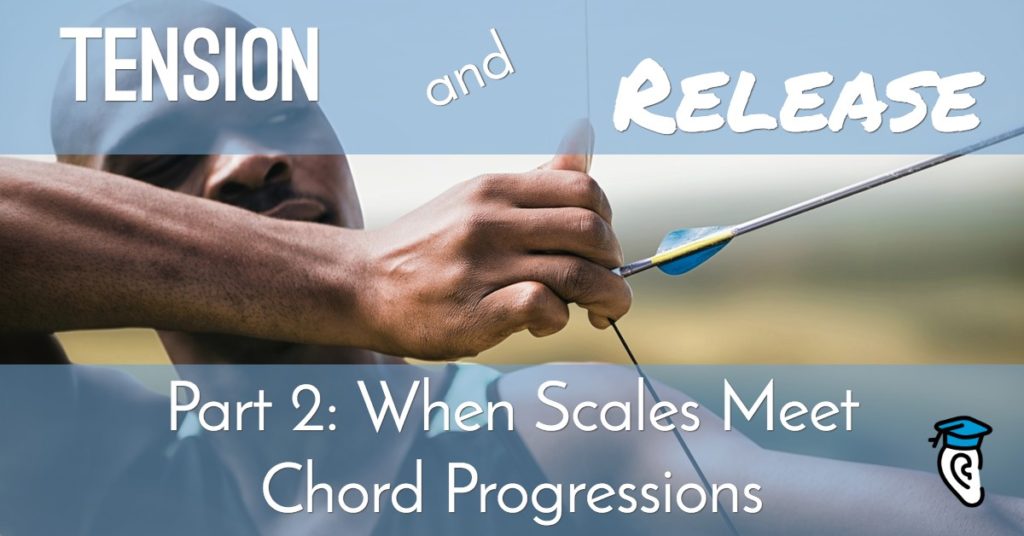Melody moves through its harmonic surroundings creating varying degrees of tension and release. As we train our ears to perceive tension and release, we gain deeper appreciation as we listen to music and greater mastery in composing, improvising, and playing by ear.
Last time we played varying tones of a major scale (scale degrees) over a single unmoving chord. We listened to how each note sounded against the chord and discovered how the notes in the chord (chord tones) sounded stronger or more at home than the other scale tones.
Now we will move past single chords and listen to how each scale degree sounds when we move from one chord to another in a chord progression. This is a very important exercise. You will repeat each scale tone over each chord in the progression before moving on to repeat the exercise with the next scale tone.
How to Maximize Your Experience
Even though the audio examples are supplied with this article, it is extremely important that you play them yourself. Here are two ways to do this:
- Play the chords with your left hand and scale tones with your right hand on the piano.
- First, record yourself playing the chords on keyboard or guitar. Then play the melody note on your instrument with the recording.
Listen to how each scale tone will go from either a tension tone to chord tone or the reverse depending on the chord it is played over. Context is important, and as you play through the examples you will realise how one note will sound great with one chord then sound completely different against the next. Not only is it a very interesting exercise but it will train your ear to want the resolution.
When playing through each example, simply hear the note as it is. Try not to resolve it if it needs to. Just let it go. Take in the quality of tension or release that you experience, and fix it in your budding aural memory banks.
Note: in the following examples, we will be referring to tones relative to the root of the chord. This is what the terms like root, third, fifth (chord tones), and fourth and sixth refer to. If you are hazy on these terms, check out Learn to Play by Ear Using Chord Tones.
Fixed Scale Tone, Moving Chords
In these examples, we will listen to the steps of a C major scale one at a time as the chord progression moves under them. We have chosen the I-V-vi-IV progression, which is one of the most popular chord progressions of all time.
Following each audio example, you will find the notation and a list of how the scale degree relates to each chord. As you work through these exercises yourself, you will begin to hear those specific relationships and be able to use them in your listening, music creation, and playing music by ear.
For example, sometimes the scale note combines with the chord triad to create a seventh chord. In those cases, you will notice a lessening of tension, since the sevenths are very common chord extensions in our musical system.
Root
Let’s begin with the root of the C major scale. The C note works well over most chords in this progression. It is a chord tone over all the chords except the G. You should hear tension on this chord.

Relationships:
- C is the root of the 1st chord.
- C is the 4th of G, this should create tension.
- C is the minor 3rd of the Am.
- C is the 5th of F.
Second
D is the 2nd note of the scale. It should create some tension on all chords except the G.

Relationships:
- D is the 2nd of C and will want to resolve.
- D is the 5th of G and will sit well.
- D is the 4th of Am minor, a tension tone in this context.
- D is the 6th of F. There will be some tension over this chord.
Third

Relationships:
- E is the 3rd of C. A safe chord tone to use as it defines the quality of the chord—in this case a major chord.
- E is the 6th of G.
- E is the 5th of Am.
- E is the Major 7 of F. This is an interesting one. When using 4 note harmony E can be a chord tone. making up the chord of 1 3 5 7 (F A C E). To some the E can can work, but to other ears it will want to resolve. To me it still has that need or pull towards the root of the chord F.
Fourth

Relationships:
- F is the 4th of C, you will hear a lot of tension on this one.
- F is the flat 7 of a G chord. This is generally a chord tone if the Chord was a G7.
- F is the minor 7th of G
- F is the minor 6th of Am
- F is the root of F.
Fifth

Relationships:
- G is the 5th of C.
- G is the Root of G.
- G is the minor 7th of Am.
- G is the 2nd of F
Sixth

Relationships:
- A is the 6th of C
- A is the 2nd of G
- A is the root of Am
- A is the 3rd of F
Seventh

- B is the major 7 of C
- B is the 3rd of G
- B is the 2nd of Am
- B is the augmented 4th (#4) of F.
Moving to Resolution
The next set of examples plays the scale tone followed by the release, in this case the closest chord tone. If the note is already a chord tone it is then played again. As you can see in some examples there are options. The resolution can either go up or down. This exercise can obviously be exhausted to try endless possibilities.
Root Resolving to Chord Tone

Second Resolving to Chord Tone


Third Resolving to Chord Tone

Fourth Resolving to Chord Tone

Fifth Resolving to Chord Tone


Sixth Resolving to Chord Tone


Seventh Resolving to Chord Tone


Creating Melodies: Putting Tension and Release to Work
Now let’s look at some melody ideas. I have kept the same rhythmic theme throughout most of it. But you’ll hear how this concept can really help create melodies.

Flying Solo: Your Turn
Here’s a backing track that you can use to try out your own tension and release.
At first, follow my lead and try to create a consistent rhythmic theme throughout the four bars. Change octaves to add variation. You can repeat the four bars and change the last bar to create an eight bar passage. It is absolutely limitless! Have fun experimenting and expanding your ears.
Now that you’ve run through these exercises, invent your own with different scales and chord progressions. As you play with these exercises, you will soon see the musical benefits. The qualities of tension and release in music will be real, tangible and nameable—ready at your command to create the music you really want to create!







